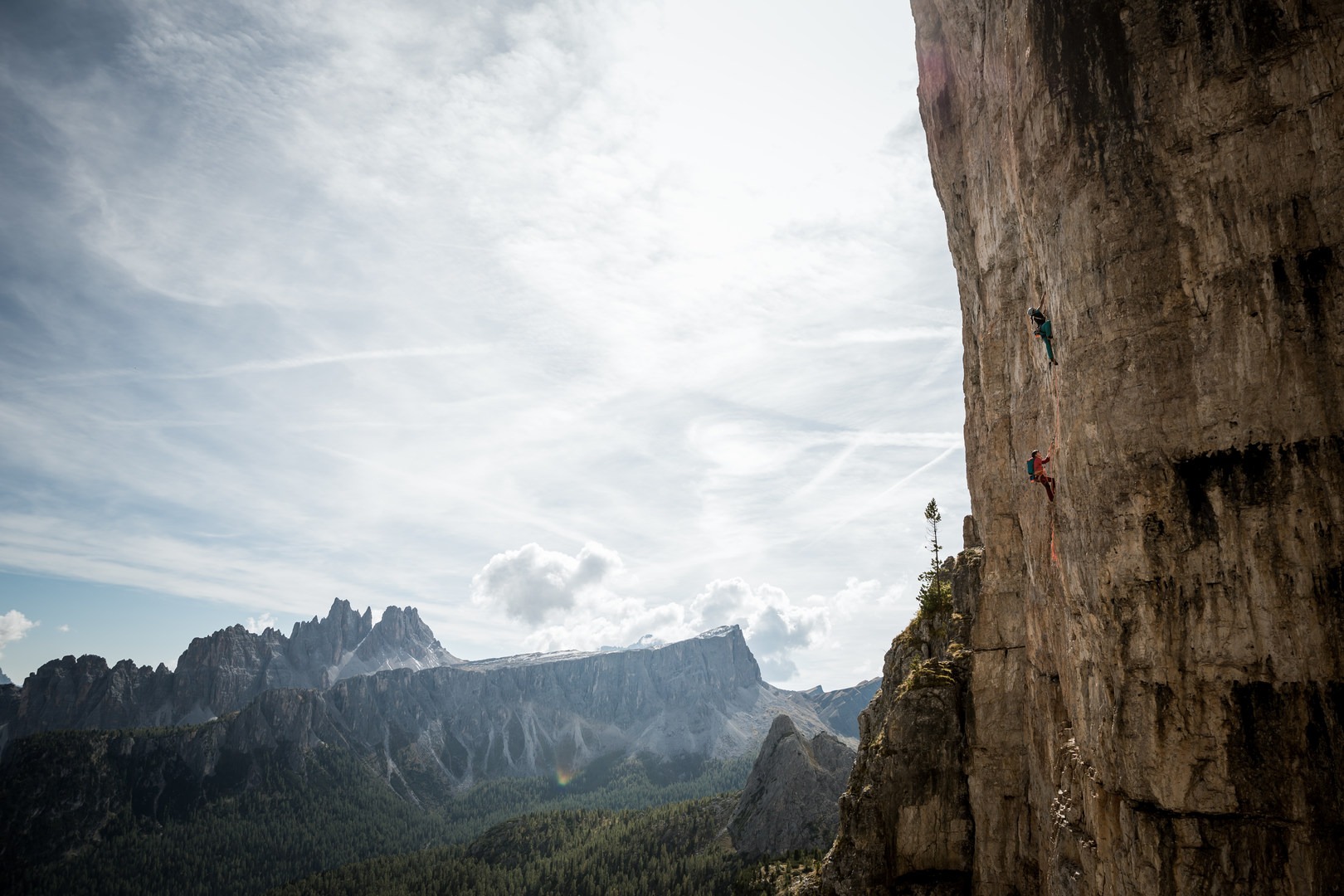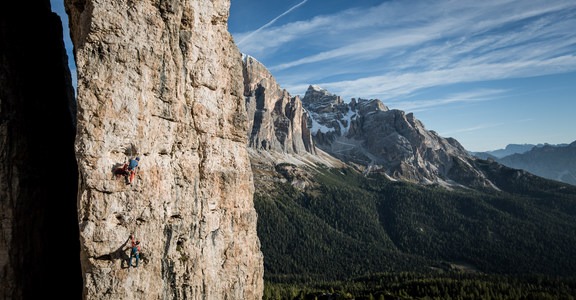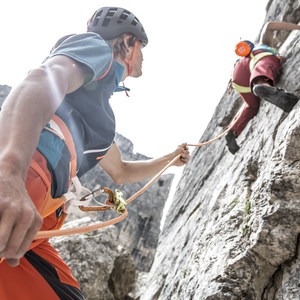Belay stations
The anchor is the “safe haven” for a rope team. It should hold during any potential fall – whether it’s the lead climber or the follower. It therefore plays a central role in alpine climbing.
At first glance, anchor building appears quite complex: the climber must use different systems depending upon the quality of the anchor and the belay method. The climber typically chooses between either a series connection or a distribution of load. In other regions, different anchors such as the South Tyrolean method are widespread. The reasons for these different systems are the various circumstances, such as the number and quality of anchors, the pulling direction, the position in relation to each other as well as the belay methods.
Irrespective of the system that is used, every anchor has a central point where the personal anchor and the partner’s belay meet. It is important that this is properly and clearly arranged so that the climber can work quickly and effectively. If you understand the rules, you can build anchors safely, quickly and clearly!
When do I use what?
Essentially, there are two types of anchors: a series connection or a distribution of load. The classic series connection is used for solid anchors. Here one anchor (bolt) is put under strain, while the second, unburdened anchor serves as a redundancy. This means that there is a backup for the first anchor if the first one should break. The series connection can be set up with a climbing robe or a pre-prepared belay sling with a bowline on a bight (double bight). This system is for use exclusively with good anchors.
A distribution of load is used for questionable anchors, such as normal pitons or traditional climbing equipment. In this scenario a single anchor should not solely be put under strain, and instead the acting forces should be distributed across all anchors. If an anchor breaks, the others take the strain without jolting. NOTE: Always set up a distribution of load with questionable anchors!
Series connection
- Good anchors (bolts) and at least one solid anchor.
- In a series connection, a load is always applied to the lower anchor; the second is applied behind it as a passive redundancy.
- Anchors are stressed in sequence (one after the other), in case the first one gives.
Belaying to a solid anchor
If an anchor has sufficient sturdiness in all directions, a belay can be set up at that point. In addition to standard bolts, a belay with only one anchor can be set up on a rocky knoll, a block, an arm-thick tunnel or a thick tree.
If there is a risk of the anchor failing as a result of an upward shift (e.g. in the case of a rocky knoll belay), the anchor must be braced. If this is not possible, in exceptional circumstances it is to be braced with the belayer’s bodyweight. In this case, the belay is set up at the anchor using the body and a dummy runner. The dummy runner will prevent a falling individual from falling onto the belayer: It provides protection that – in the event of a belay fall – ensures that the fall tension in the belay device will act upwards and the belayer can stop the fall.
Belay on a tree
Trees can be used as a belay. Here a sling is wrapped around a tree with a girth hitch so that it cannot move upwards. A belay tree should still be green, meaning it has not died and is not rotten. The diameter of the tree should be at least as thick as a leg.
Tunnel belay
To be able to make a tunnel belay, the tunnel should be at least as thick as an arm at its weakest point and should not have any cracks. Here the climber threads a sling through the tunnel. A girth hitch is not used, as this would automatically move to the narrowest, and therefore least sturdy, point of the tunnel. Instead the climber threads a sling around the outcrop so that the load is applied to its base – the most solid point of the tunnel.
Belay on a rocky knoll
In alpine terrain, rocky knolls are often used for belaying. Beware: If the sling can be lifted upwards or sideways in the event that the lead climber falls, the central point must be braced. If this is not possible, it must be braced with the belayer’s bodyweight and a dummy runner used.
Belaying to two solid anchors
If you are climbing on a route where belays are set up with two solid bolts each, a series connection is to be used. If the climbers alternate who takes the lead, the belay can also be set up with a climbing rope instead of a belay sling: To do so, the climber should hook a carabiner onto both anchors, fasten him/herself with a clove hitch to the lower anchor – which also serves as the central point – and then use another clove hitch to attach the rope to the second carabiner.
If it is unclear who the lead climber is, the lead climber is fixed or there is a three-person rope team, the belay is set up using a belay sling.
The sling’s bowline serves as the central point at the lower anchor. This is where the climber protects him or herself. Next, the upper anchor is shifted to and the sling is shortened accordingly with an over hand knot or clove hitch.
- Attach prepared belay sling. The bowline on a bight acts as the central point at the lower anchor.
- Set up personal anchor. For personal anchor purposes, the appropriate length of rope is clipped onto the locking carabiner by means of a clove hitch.
- Inserting belay device. Now the belay device is hooked in (plate/ATC for belaying, HMS carabiner or ATC for lead climber belaying).
Belaying to one solid (bolt) and removable/gear anchor
A series connection can also be applied at two anchors of unequal quality if one solid anchor is available. Along with the solid anchor, normal pitons, nuts or camming devices can be used for the second anchor.
The series connection can be set up either with a rope (if the climbers alternate who takes the lead) or with a belay sling. Here it is important that the central point is always positioned at the lower of the two anchors – regardless of the quality.
If you are unsure about the quality of the “solid” anchor, you should use a distribution of load!
Series connection summary
- Get an overview, assess anchors.
- Hook in the central point at the lower anchor.
- Personal anchor in central point loop.
- Shift to upper anchor and crop to length.
- Hook in belay device for belaying.
NOTE: The central point is always clipped onto the lower anchor. If both anchors are at equal height, then the central point is always at the anchor pointing in climbing direction!
Distribution of load
- For gear anchors or questionable fixed anchors, the load is distributed as evenly as possible across all anchors
- If one of these anchors gives, the others pick up the load without jerking
- All anchors are to be connected to each other as an active redundancy
Belaying to two removable (cam devices or nuts) anchors
If there are two removable points or only two questionable anchors, the anchor should be improved. If that isn’t possible and no other anchor is available, the climber must then set up a distribution of load. The force is distributed across both anchors in the belay. In the event of a fall, the force is distributed as equally as possible across both anchors and if an anchor breaks there will be no additional force added to the system.
For two gear or questionable anchors (e.g. normal pitons), the climber clips a sufficiently long sling onto the upper and lower anchor for the distribution of load. Then he/she clips on a central point carabiner using a clove hitch or a girth hitch knot.
South Tyrolean anchor
The climber does not use any carabiners at the anchors when setting up a South Tyrolean anchor. Instead, the anchor is set up using a sewn sling or an open Kevlar or Dyneema cord, so that the climber can connect it quickly and easily to multiple anchors. To avoid time-intensive tying and untying of knots, the central point carabiner is attached to the sling using a girth hitch knot.
If an open Kevlar or Dyneema cord is used, this is tied with a simple over hand knot after threading.
Belaying to multiple questionable or mobile anchors
For a belay with several questionable anchors, such as on normal pitons, nuts or camming devices, the load must be distributed. All anchors are to be connected to each other with a long Dyneema or Kevlar cord (5.5mm, 6–7m) or a long, sewn Dyneema sling (2.5m). Open Kevlar or Dyneema cords are tied with an over hand knot. The central point is then attached to a locking carabiner with a girth hitch knot.
- Threading through all anchors. To do this, the open cord is looped through all the anchors and then knotted with an over hand knot.
- Set up central point. Now drag all the loop sections down between the anchors and create an equalized central point with a locking carabiner by girth hitching a carabiner.
- Personal anchor and partner belaying. Now the personal anchor and the partner’s belay are clipped on at the central point.
Distribution of load summary
- If there are two removable points or only two questionable anchors, the anchor should be improved. If that isn’t possible and no other anchor is available, the climber must then set up a distribution of load. The force is distributed across both anchors in the belay. In the event of a fall, the force is distributed as equally as possible across both anchors and if an anchor breaks there will be no additional force added to the system.
- For two gear or questionable anchors (e.g. normal pitons), the climber clips a sufficiently long sling onto the upper and lower anchor for the distribution of load. Then he/she clips on a central point carabiner using a clove hitch or a girth hitch knot.
Check out the full series of Safety Academy Lab Rock videos below:
- Alpine basics
- Basic equipment for every climber
- Basic equipment for groups
- Additional equipment for groups
- Storms in the mountains
- Types of rock in the Alps
- Tour planning for alpine climbing
- Packing a backpack correctly
- Rope team procedures
- Knot techniques
- Belay using bolts
- Belay methods
- Anchors
- Coiling a climbing rope
- Rappelling
- What to do in an alpine emergency
- First aid on the mountain
- Rescue techniques while alpine climbing
- Bivouacking in an emergency situation
Visit ORTOVOX’s Safety Academy Lab Rock to view the climbing tutorials in their totality and test your knowledge with their fun and interactive quizzes.
Since the company was founded in 1980 in the south of Munich, ORTOVOX has stood for the highest possible protection during alpine activities. As pioneers in the avalanche safety field, we have played a key role in the development of emergency equipment for the mountains. Innovations such as the double-frequency avalanche transceiver and Smart Antenna Technology, and also targeted training measures, continue to be valuable contributions to making mountain sports a little bit safer and to saving lives.






Comments
If an open Kevlar or Dyneema cord is used, this is tied with a simple over hand knot after threading."
To the best of my knowledge this is completely erroneous - the minimum being a triple fisherman's if using a technora type sheathed cord.
Sign In and share them.